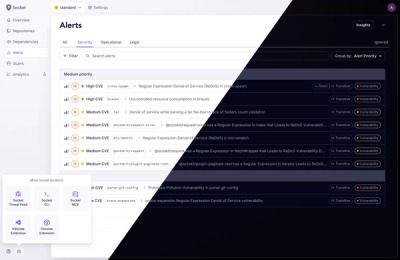
Product
A Fresh Look for the Socket Dashboard
We’ve redesigned the Socket dashboard with simpler navigation, less visual clutter, and a cleaner UI that highlights what really matters.
(In Development Mode)
Cloudq is a job queue system that allows you to publish or subscribe to queues anywhere in the cloud.
Cloudq_Client is a ruby implementation of the cloudq protocol that makes publishing jobs and consuming jobs in ruby, very easy.
For more information on the cloudq protocol see http://cloudq.heroku.com
You need a cloudq job server, if you do not have a cloudq job server to connect to, then you need to set one up. If you do have a cloudq server, then for this client to work you need the following:
And the Cloudq Gem depends on the rest-client gem, but it should install when you install the gem.
gem install cloudq_client
require 'cloudq'
Cloudq::Connection.url = 'http://your.cloudq.server'
# Publish Job to a queue called - awesome
Cloudq::Publish(:awesome).job 'Awesome', :type => 'Sauce'
require 'cloudq'
Cloudq::Connection.url = 'http://your.cloudq.server'
# Check Q every 5 seconds
Cloudq::Worker.new(:awesome).run do
print '.'
sleep 5
end
FAQs
Unknown package
We found that cloudq_client demonstrated a not healthy version release cadence and project activity because the last version was released a year ago. It has 1 open source maintainer collaborating on the project.
Did you know?

Socket for GitHub automatically highlights issues in each pull request and monitors the health of all your open source dependencies. Discover the contents of your packages and block harmful activity before you install or update your dependencies.

Product
We’ve redesigned the Socket dashboard with simpler navigation, less visual clutter, and a cleaner UI that highlights what really matters.

Industry Insights
Terry O’Daniel, Head of Security at Amplitude, shares insights on building high-impact security teams, aligning with engineering, and why AI gives defenders a fighting chance.

Security News
MCP spec updated with structured tool output, stronger OAuth 2.1 security, resource indicators, and protocol cleanups for safer, more reliable AI workflows.